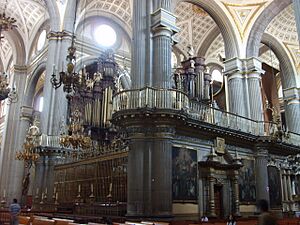Juan Gutiérrez de Padilla facts for kids

Juan Gutiérrez de Padilla (around 1590–1664) was a Spanish composer who wrote music in the style of the Renaissance. He spent most of his life working in Mexico.
Contents
Life and Career of Juan Gutiérrez de Padilla
Juan Gutiérrez de Padilla was born in Málaga, Spain. He learned about music from Francisco Vásquez. Vásquez was the maestro de capilla (music director) at Málaga Cathedral.
In 1612, Padilla became the music director at a church in Jerez de la Frontera. He tried to get the same job at Málaga Cathedral in 1613 but didn't succeed. He stayed in Jerez until 1616. Then, he became the music director at Cádiz Cathedral.
Between 1620 and 1622, Padilla moved to Puebla, Mexico. At that time, Mexico was part of a large Spanish territory called New Spain. This territory included modern-day Mexico, Guatemala, the Philippines, and other parts of Central America and the Caribbean.
Puebla was a very important religious city in the 1600s, even more so than Mexico City. Padilla started working at Puebla Cathedral as a singer and assistant. The main music director there was Gaspar Fernandes. After Fernandes passed away, Padilla became the new music director of the cathedral in 1629.
By 1645, Padilla was in charge of 14 choir boys and 28 adult singers. Some of the musicians who worked under Padilla later became important composers themselves. These included Francisco López Capillas and Juan García de Zéspedes. Juan García de Zéspedes was a boy soprano in the choir. He later took over Padilla's job as music director in 1664.
It's important not to confuse Juan Gutiérrez de Padilla with a younger composer also named Juan de Padilla. That other Juan de Padilla was a music director in other Spanish cities later on.
Musical Works of Juan Gutiérrez de Padilla
Juan Gutiérrez de Padilla wrote a lot of music. More than 700 of his pieces still exist today! Most of his music was for church services.
He wrote many sacred motets. A motet is a type of choral music, often sung without instruments. Padilla often wrote for two choirs singing at the same time. His music was in the Renaissance style, also known as stile antico (meaning "old style"). This was a traditional way of composing music.
He also wrote sacred villancicos. A villancico is a type of song that was popular in Spain and Latin America. These songs often included parts for instruments like the organ or different stringed instruments.
Recordings of Padilla's Music
Even today, people still perform and record Juan Gutiérrez de Padilla's music. Many groups have recorded his Masses, motets, and villancicos.
Some of his famous pieces that have been recorded include:
- Missa Ego Flos Campi (a Mass)
- Stabat Mater (a hymn)
- Mirabilia testimonium (a motet)
- Lamentation for Maundy Thursday (a piece for Holy Week)
- Salve Regina (a Marian hymn)
- Missa Ave Regina (another Mass)
Groups like the Westminster Cathedral Choir, The Harp Consort, The Sixteen, and The Tallis Scholars have recorded his works. Conductors like James O'Donnell, Andrew Lawrence-King, Harry Christophers, and Peter Phillips have led these recordings.
Benjamín Juárez Echenique has also recorded some of Padilla's music. These recordings include his Christmas villancicos and parts of his Missa Ego flos campi.
See also
 In Spanish: Juan Gutiérrez de Padilla para niños
In Spanish: Juan Gutiérrez de Padilla para niños

